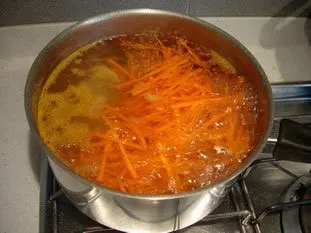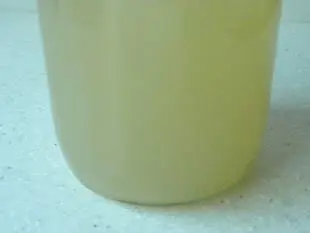The blog of cooking-ez.com
Perpetual stock

It's something you have probably have done yourself: cooked or pre-cooked vegetables before adding them to a recipe. This is almost always done the same way: peel the chosen vegetables (carrots, for example), cut them up, boil them in salted water (using a tablespoon or so of coarse salt per litre), then cool them rapidly in cold water to stop the cooking. They are then ready to use in the recipe.
23K 12 5
Last modified on: November 22th 2016
Perpetual stock
This very simple way of cooking (the French call this “English style” ) not only cooks the vegetables, but leaves us with something else: a vegetable stock. As they cook, the vegetables release some of their flavour into the water. So, if you have several different kinds of vegetables to cook the same way, you will end up with an excellent stock which is far too good to throw away! To make use of it, simply let it cool, then filter it into a bottle (or other container) with a lid that seals well and keep it in the fridge.
Next time you need to boil vegetables again, instead of using a pan of fresh water, re-use your stock, and your vegetables will taste even better (add more water and/or salt if necessary).
Each time you repeat the operation, the richer and more flavoursome your stock will become. This doesn't only work with vegetables; you can use it to cook meat as well – which will improve your stock even further with a stronger flavour.
A few guidelines:
- If you are poaching seafood, the flavours are distinctive, so it is better to keep a separate stock on the go, rather than mix “surf” (vegetables + fish or shellfish), and “turf” (vegetables + meat).
- Even in the fridge, the stock won't keep very long, so if you do not use it within the next week to 10 days, either freeze it or boil it up again on its own.
- When you are making soup, use your stock rather than plain water (or top up with water) – you will be amazed at the difference in flavour.
- If you boil potatoes in the stock, peel them first, as the skins will do nothing for the flavour, other than add an unpleasant “earthy” taste.
- If you are making stock for the first time, you don't need to start it from scratch. Add ½ an onion (peeled) to the salted water and, if possible, a bouquet garni, or at least a handful of leek greens and a spring of thyme to give it a head start. Even better, you can start by making a more sophisticated version, a real vegetable stock.
- Don't be too quick to condemn commercially available stock cubes – they are practical and can be a good way to start a perpetual stock, especially if they are organic, but do check the label carefully to see what is in them.
To sum up: Do not throw away cooking water used to boil vegetables or poach fish or meat - this is no longer just water; it is now a delicious stock that can be perpetually reused and added to: the ultimate in kitchen recycling.
Stock (or bouillon) has long been a cornerstone of French cuisine. It is worth remembering that to the French, “bouillon” is a familiar term for a basic popular eatery. Back in the 17th and 18th centuries, in the streets of Paris and other large towns, there were little shops or stalls known as “marmites perpétuelles” (perpetual pots) where huge cauldrons containing a bouillon of vegetables and meats (mostly poultry), simmered away day and night over low fires, and from which one could buy a bowlful at any hour of the day. Each time a bowlful was served, more water was added to the pot and more vegetables and meat were added to replace what was taken out. After all those hours of slow cooking, the resulting mixed broth had a robust and quite unique flavour.

Next time you need to boil vegetables again, instead of using a pan of fresh water, re-use your stock, and your vegetables will taste even better (add more water and/or salt if necessary).
Each time you repeat the operation, the richer and more flavoursome your stock will become. This doesn't only work with vegetables; you can use it to cook meat as well – which will improve your stock even further with a stronger flavour.
A few guidelines:
- If you are poaching seafood, the flavours are distinctive, so it is better to keep a separate stock on the go, rather than mix “surf” (vegetables + fish or shellfish), and “turf” (vegetables + meat).
- Even in the fridge, the stock won't keep very long, so if you do not use it within the next week to 10 days, either freeze it or boil it up again on its own.
- When you are making soup, use your stock rather than plain water (or top up with water) – you will be amazed at the difference in flavour.
- If you boil potatoes in the stock, peel them first, as the skins will do nothing for the flavour, other than add an unpleasant “earthy” taste.
- If you are making stock for the first time, you don't need to start it from scratch. Add ½ an onion (peeled) to the salted water and, if possible, a bouquet garni, or at least a handful of leek greens and a spring of thyme to give it a head start. Even better, you can start by making a more sophisticated version, a real vegetable stock.
- Don't be too quick to condemn commercially available stock cubes – they are practical and can be a good way to start a perpetual stock, especially if they are organic, but do check the label carefully to see what is in them.
To sum up: Do not throw away cooking water used to boil vegetables or poach fish or meat - this is no longer just water; it is now a delicious stock that can be perpetually reused and added to: the ultimate in kitchen recycling.
Stock (or bouillon) has long been a cornerstone of French cuisine. It is worth remembering that to the French, “bouillon” is a familiar term for a basic popular eatery. Back in the 17th and 18th centuries, in the streets of Paris and other large towns, there were little shops or stalls known as “marmites perpétuelles” (perpetual pots) where huge cauldrons containing a bouillon of vegetables and meats (mostly poultry), simmered away day and night over low fires, and from which one could buy a bowlful at any hour of the day. Each time a bowlful was served, more water was added to the pot and more vegetables and meat were added to replace what was taken out. After all those hours of slow cooking, the resulting mixed broth had a robust and quite unique flavour.
Lasts posts
Toss the salad
When you've finished preparing a salad, green or otherwise, it's usually time to add the dressing and toss. It's often said to "toss the salad", which means to season and mix. Is it easy? Not so easy...2,0995 March 8th 2024
Half milk, half cream
In a multitude of recipes, savoury or sweet, milk is used as the main ingredient, or at least as the main liquid ingredient. Milk is used instead of water, for example, because milk contains a proportion of fat, which adds roundness and softness to the recipe. This mellowness is very pleasant on...2,105 February 27th 2024
Cutting soft cheeses
As you may have already noticed, when you have to use a "soft" cheese in a recipe - their exact name is "soft cheese" - such as Camembert, Munster or Mont d'or, it's not easy to make anything other than thick slices.2,2435 February 20th 2024
It's spinning too fast!
When you need to grate or slice vegetables, you generally use an electric machine that does all the work: a food processor, a mixer with a "slicer" extension or similar. Are these machines really suitable? Generally speaking, yes of course, but there's one criterion that often poses a problem,...5,1075 November 12th 2023
When I was a kid, I didn't like...
Maybe you've already made this strange observation: when you were a kid, there were things you hated, but as an adult it's almost the opposite? For example, you used to hate spinach or chicory, but now you love it?4,7445 November 5th 2023
Other pages you may also like
What is the difference between bakery and patisserie?
This is a question that you may well have asked yourself and which I will attempt to answer. In France the two trades of "boulangerie" (bakery) and "pâtisserie" (patisserie and confectionery) have always been quite distinct, but where exactly do the boundaries lie? .119K 14.1 February 7th 2017
What can I use for blind baking a pastry case?
When it comes to home-made desserts, tarts are always popular. They can be divided into two basic types: those cooked with their filling, such as an apricot and almond cream tart, and those where the filling is added after baking the pastry case, such as a strawberry tart or chocolate tart. For...104K4.5 May 2nd 2017
The so-called "nervous" meats
You've probably heard this before, we're talking about "nervous" meat, or meat with nerves, to describe what is indicated by the blue arrow on the left. This is a piece of beef, and what we call a nerve is not a nerve, it is in fact collagen (chemists sometimes call it a "collagen sink"), a...22K4.5 April 16th 2021
Fruits which can ruin your jelly
There are many ways of making a fruit mousse, but one of the simplest is to prepare a fruit jelly (basically a fresh fruit coulis with gelatine) and then mix this jelly before it sets completely with whipped cream. The result is perfect for filling a charlotte, for example. But do beware;...67K4.0 March 6th 2013
Stand mixer tools
Whether we call it a stand mixer, food processor, or simply refer to it by brand (Kenwood, KitchenAid, etc.), this machine is a valuable tool for amateur cooks, bakers or pastry chefs like ourselves. All these machines come supplied with 3 different tools. Let’s take a look at their names and...31K4.5 November 2nd 2019
Follow this page
If you are interested in this page, you can "follow" it, by entering your email address here. You will then receive a notification immediately each time the page is modified or a new comment is added. Please note that you will need to confirm this following.
Note: We'll never share your e-mail address with anyone else.
Alternatively: you can subscribe to the mailing list of cooling-ez.com , you will receive a e-mail for each new recipe published on the site.









